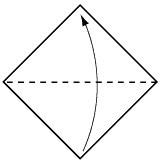It seems like math is popping up everywhere these days. Like today:
"I want to make an Origami paper crane like V. gave me," she proclaimed. V. is a new friend, about ten years old, whom she met recently. They have a lot in common, including a passionate penchant for constructing things.
Unfortunately, paper cranes are not the easiest to start with, so I found this Origami Twirling Bird at a website I've used for one of the Math in Your Feet Family Night stations. Immediately I found myself using math words and concepts as we worked to follow the folding directions.
"Here it says, 'Start with your paper white side up. Fold in half, as shown.'"
"Oh look!" I continued, "you fold point to point. Take the bottom point and fold it up to the top point, but also make sure the edges are matching."
Points and edges! Whole to half. Rotate. Fabulous. We continue along these lines when, magically, quickly, the bird is done.
We fly them, and they twirl like fall leaves. Well, almost; they actually twirl nose over tail like horizontal helicopter seeds. If they could make a sound they'd be giggling. Time for lunch.
While I'm in the kitchen Isobel says, a piece of cloth in hand, from the other room, "You could do Origami with fabric!" "Really?" I counter. "Would the cloth really be able to hold its shape?" There is quiet, and then an exclamation:
"Look Mama! I can do Origami with my body!"
 |
| Body Origami: Paper Crane |
Lunch is still not ready. "Hey Isobel," I say, "Come in here and fly your birds. Which way are they twirling, do you think? Nose over tail, or wing over wing?"
Flying ensues.
I'm still working on lunch and then, spoken rhythmically from the next room,
"Wing over wing does a spinning bird spin? Ha ha! Head over heels!"
And there, ladies and gentlemen, is our multi-modal, multi-disciplinary math lesson for the day: a fine motor, gross motor, kinesthetic, auditory, visual, language based and personally expressive math lesson.


I know no one has commented on this yet but I really loved re-reading this post almost three months after the fact! Just one small example of the potential for flow between learning and discovery and self-expression.
ReplyDelete